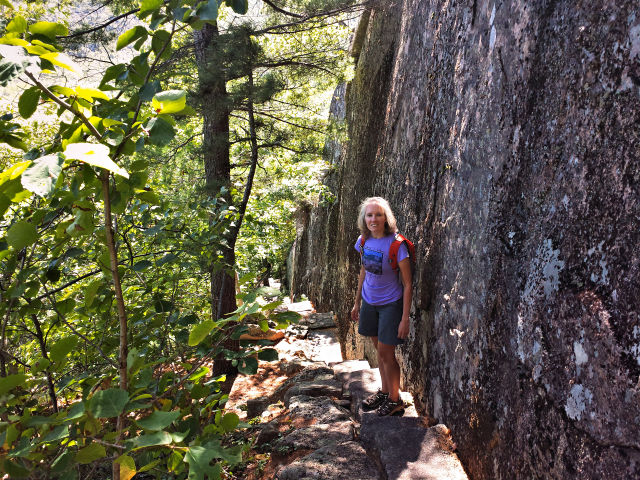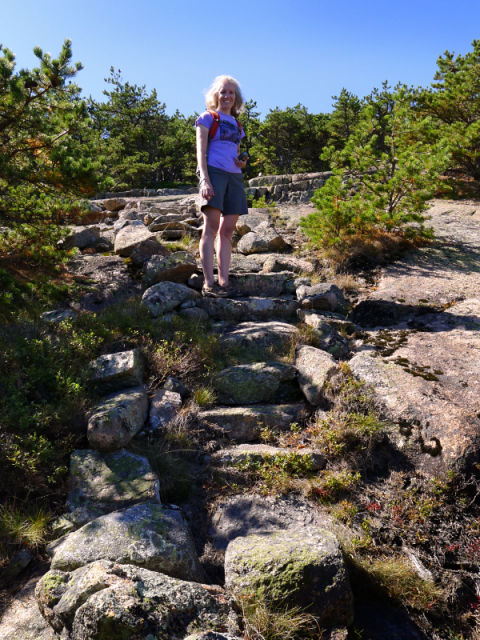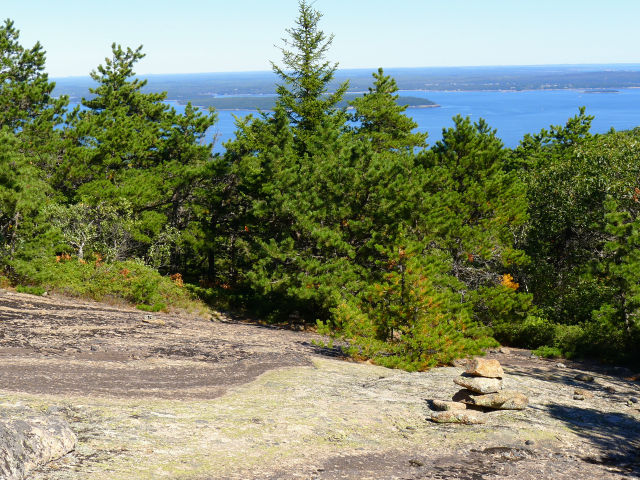We usually like to choose a tough challenge for our last day. It either gives us a satisfying ending to a great trip, or it gives us another reason to look forward to coming back, or sometimes both. This time we chose the search for the abandoned portion of the Ladder Trail, what I’ll refer to as the Upper Ladder Trail.
The Upper Ladder Trail
The history of the Ladder Trail is confusing and documentation, at least what documentation I have access to, is sparse. The first hint of a trail along this particular route is found in the writings of Benjamin Franklin DeCosta’s 1871 “Rambles in Mount Desert.” On pages 91-92 he writes:
Our destination was the top of Green Mountain, and another scramble was inevitable. Therefore, without much delay, we struck through the pretty strip of wood skirting the foot of the eminence, found a narrow wooded ravine, and, keeping where we could take advantage of the trees, worked our way up. From the foot of the mountain we saw little more than what appeared an almost perpendicular granite wall, but we were gratified to find this convenient groove, though it was filled up with immense masses of fallen rocks, over which we were forced to climb. After an hour’s labor we were finally able to overlook the peak of Newport and view the sea. In a quarter of an hour more we were on the top of this spur, called Dry Mountain, picking blueberries and seeking for the best way across the ravine which separated us from Green.
Pathmakers considers this a reference to the proto-Ladder Trail; I’m not so sure, but perhaps the authors’ knowledge of the area allows them to draw conclusions that I cannot. As far as I can determine, the officially named, constructed Ladder Trail was originally built in the 1890s by pathmaker Waldron Bates’s crew using a series of ladders and some small steps (the size of which was often limited by the size of rock the men could carry!).
The trail was rebuilt by the CCC beginning in 1934. Soon after, the upper section (still containing 175 Bates steps) was abandoned when it was decided that it was superfluous—that the East Face/Schiff path would be sufficient to get hikers to the summit from Dorr’s east face trails.
Of course, we had to find this abandoned upper section containing original Bates steps! It’s been in the back of my mind for a few years, after I noticed the following (accompanied by a photo of stone steps) in Trails of History (p. 58):
Upper Ladder Trail. Although currently abandoned, this section of the Ladder Trail is an excellent example of Waldron Bates’ work.
Enticing!!! But we never seriously considered looking for it until today.
Very little has been published about the upper section of the Ladder Trail. Pathmakers contains a few references to it, as does Trails of History as noted above. But with nothing more than a few photos and the text “Route: From the lower section of the Ladder Trail up to the ridge near the summit of Dorr Mountain” to go on, we had no expectation of finding it today. We just wanted to explore the area in person and get a sense of the topography.
First, the fuel-up was at Jeannie’s. We hadn’t yet gone there this year, but we noticed each morning we went by how it was at least as busy as in years past when Jeannie was running the place. So maybe the nonexistent crowds of the last year or two were just an anomaly and not the beginning of a trend. We were seated after a wait of about 15 minutes, not too bad. The place was as bright and cheery as ever, and the food was excellent. I got my usual single strawberry pancake, to which I always add Jeannie’s homemade strawberry rhubarb jam. (We also bought six jars of this jam to bring home.) Rich had an egg sandwich on oatmeal toast and wanted me to note that it was the best egg sandwich he’s had on the island yet. We had the usual Earl Grey tea and coffee.
Our search for the Upper Ladder Trail
We began our adventures as we’ve begun many others, by riding the Island Explorer bus to Sieur de Monts. From there we hiked the Kane Path along the western shore of the Tarn to intersect with the base of the Ladder Trail. Even the Kane Path is a bit of a workout for legs and ankles as you wend your way through and over large talus boulders. But it doesn’t nearly compare to the workout that is the Ladder Trail—basically a continuous staircase winding its way straight up the eastern face of Dorr Mountain!
Three ladders and over a thousand steps later, we were at the intersection with the Schiff Path, where we began our search for the Upper Ladder Trail. Unfortunately, nothing at this spot indicated that there could possibly have been a trail leading off to the west. The high bluff continued to our left, and to the right the Schiff Path began its descent.
I decided to hike upwards while Rich headed back down a short distance. In most cases you need to check potential side trails or even bushwhack for a short distance before receiving any confirmation that you’re on the abandoned section of a trail. Neither of us found anything, and I met Rich back at the Schiff Path intersection.
“Let me just check the area below the intersection once more,” I said. I wanted to have a good memory of the area so that if during the next year I discovered more about the trail I might know where to look in relation to the bluff or the continuous rock wall. I descended until I was satisfied that I was well beyond any possible intersection with the Upper Ladder; the high solid wall was still on my right as far down as I could see. At that point I turned around and headed back up, watching carefully for anything that looked unusual.
“Hmm, interesting,” I thought when at one point I saw three or four step-sized rocks embedded in the dirt bank to my left. This was at the break between the solid wall and the bluff higher up. They weren’t obvious steps, but they might have been at one point. In any case they looked oddly out of place. I had to investigate.
I climbed on top of them and immediately saw a very small path that one would easily mistake for a game trail or a small erosion gully, but underfoot here were some rocks of a similar size. I followed this ankle-wide trail up and to the left through some blueberry bushes toward the top of a small ledge. Before even reaching the ledge, a set of a few crude but unmistakeable steps led upward. Great sign. When I reached the ledge, I saw a single rock perched atop a large boulder on the ledge. “Could be a cairn,” I thought. I looked beyond it to the next large boulder: a definite cairn of four stones was perched on it. And the same on another large boulder beyond.
It was a moment of exhilaration almost to match the one on our last full day three years ago when I followed a barely-there trail into the woods and found confirmation (a huge cairn) that we’d found the Potholes trail. In this case I wasn’t 100% sure I’d found the Upper Ladder trail, but I knew I had found something.
I descended again back to the main path, tripping and landing on a blueberry bush, shedding a slight amount of blood from my leg, and retrieved Rich from where he waited at the intersection with the Schiff path. “I think I found it,” I said breathlessly. “Well, if anyone could find it, it would be you!” he said. “Let’s go!”
We backtracked down to the place where I had noticed the oddly-placed rocks alongside the trail. “Ah,” Rich said, “yes. That does look strange.” Then we began to follow the narrow, root-covered trail up again and when we got to the ledge and Rich saw the cairns, three in a row on large boulders leading off into the distance, he knew.
With ease we followed the cairns and the relatively new orange flagging tape that soon began to appear on tree limbs. At no point were we unsure of which way to turn—that shows the good condition this trail is still in, and how well the trail phantoms have been caring for it. At least three series of Bates steps appeared along our journey, again, in beautiful condition, with smaller sets of three and four steps here and there to lead us over some rocky spots. There are no ladders on this portion of the trail. They aren’t necessary since as soon as the Upper Ladder begins, it’s already at an easier grade than the lower, current, section of the trail, and it only becomes less steep as it nears the summit.
It didn’t take long before we popped out at the Dorr South Ridge trail. I didn’t even realize we were there! A couple with a dog were walking by and for a minute I thought they were coming down to the Upper Ladder trail (it occurred to me that it might even be Tom St. Germain) but then Rich said no, that’s the South Ridge trail. We had made the connection!!!
We left a small cairn at the intersection, not noticeable from the trail or even from a few feet above, but helpful if you’re already in the right area and are looking for it. We’ll see if the cairn remains or if someone (park service or trail phantoms) sees fit to remove it. We don’t like drawing undue attention to the phantom trails but at the same time like to offer some bit of confirmation to those who are searching and have found the right area.
We crossed the summit on the South Ridge trail and then descended on the Schiff and Emery paths, two of Dorr’s memorial trails that are further examples of exquisite trailbuilding and the easiest and most beautiful way down the steep eastern face of the mountain. Built almost entirely of steps and stone treadway, both paths are as easy on the legs (relatively speaking) as the views of Frenchman Bay are on the eyes, especially on a cool, perfectly clear day like today. These are trails to be savored, which we did every moment as we descended to Sieur de Monts. Rich said that with each step we encountered, he said “thank you” to those who conceived and built the trails.
The lure of searching for abandoned trails has pulled us more each year since we discovered the Potholes Trail in 2012. The first and most obvious draw is the puzzle-like challenge of researching maps and old documents and following old treadways to see what we might find at the site. We’re also inspired by the connection we make with the old pathmakers as we see how they approached the challenges of dealing with the wilderness before them and making that landscape accessible and approachable to visitors while always retaining some special quality of each section of the island. Practically, of course, there is great value in mapping these trails out for our own use. By combining them with existing trails, we can make many more loops and have more options for hikes, which in most cases will be free of other hikers!
Celebrating at Havana!
Supper at Havana was delicious, unique and cooked perfectly, as always. We started with a little “treat” of pickled unripe strawberry, Spanish ham and a dot of a green sauce that I can’t quite recall what it was, but it was a tasty combination. The breads of the evening were blueberry cornbread and a many-grain bread that we both could have eaten a whole loaf of. They bring out a small tray of honey butter, white bean spread, and serrano-chile infused olive oil for the breads—also unique and delicious! We both got specials for appetizers: squash and apple soup, and cochinita pibil (spicy pulled pork) spring rolls with guacamole, black bean sauce and lime-marinated jicama. Yes, it just keeps getting better! And as if we weren’t already getting stuffed, our entrees were seasoned roasted pork with risotto and turnips (note: R. doesn’t like turnips); and empanadas filled with poblanos, corn, and several other peppers, and served with pickled cauliflower and black beans and crema. We were way too stuffed for dessert. Also I should mention that we had three mojitos between us!
We left very full and satisfied with the food and the day’s adventures, but sad that it was our last night here. On our way back to the room we stopped at the “schlock shop” on the corner of Cottage and Main to buy a third charm bracelet in the style of the other two I purchased at Jordan Pond house, which no longer carries the bracelets or the charms. We’ve never been in that particular junk shop before but it was packed! And we felt like we were interrupting some kind of Russian dance party.



